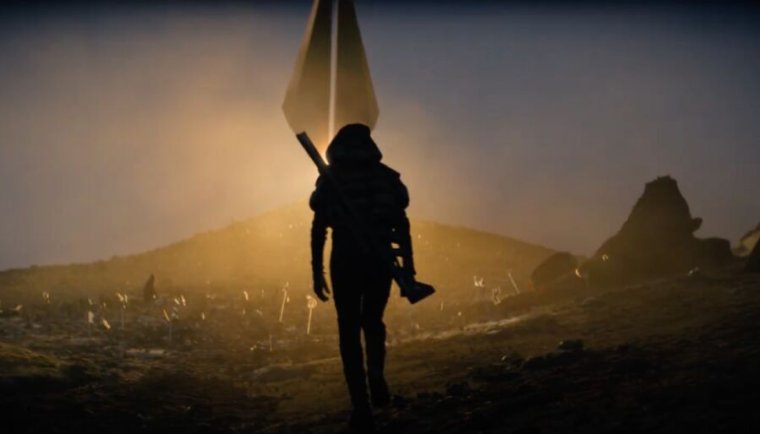
When showrunner David S. Goyer took on the monumental task of adapting Isaac Asimov's hugely influential Foundation series of science fiction novels for Apple TV+, he knew it would not be a straightforward matter. As I've written previously, the author himself admitted that he wrote strictly for the printed page, and he always refused invitations to adapt his work for film or TV.
But Asimov was more than happy to let others adapt his work to a new medium, and he was wise enough to expect that there would—and should—be significant departures from the print version. In doing so, Goyer had to strike a balance between respecting Asimov's sweeping visionary ideas without lapsing into slavish reverence and over-pontification. To my mind, he did it beautifully, producing more of a remix than a straight adaptation that is compelling and powerful in its own right.
Stream Foundation on Apple TV+
Another challenge was figuring out how to incorporate science and technology that was reasonably accurate. An astrobiologist and planetary scientist at Jet Propulsion Lab, Kevin Hand had worked with Goyer years before on Krypton, and the two had stayed in touch. So when Goyer needed a scientist with expertise in space, interstellar travel, and planetary dynamics, among other topics, naturally he turned to Hand.
Ars sat down with Goyer and Hand to learn more about the journey to bring this classic work to television.
(Some spoilers for the Apple TV+ series below, but no major reveals.)
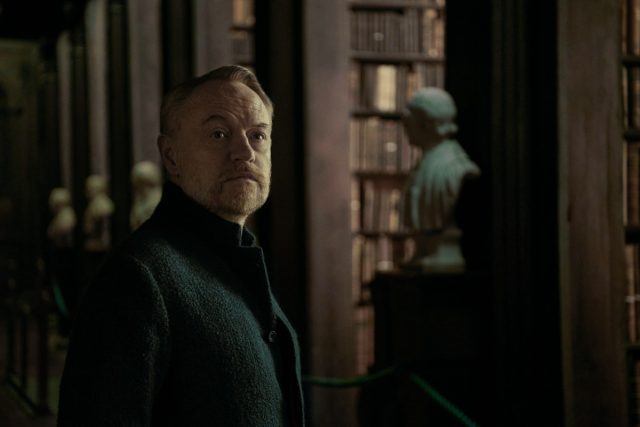
Ars Technica: It's incredibly difficult to adapt this huge body of work for the screen, even in an extended format like streaming television, in part because the Foundation series is such a beloved classic work of science fiction. What did you see as the most daunting challenges?
David Goyer: The books have been revered for 70 years. A lot of people have a very personal connection to the books. Even if you aren't a fan of science fiction, if you go into someone's library or home office, the one piece of science fiction that you will see on any serious person's bookshelf is Foundation. That's a tremendous responsibility. But I also knew that if the show was going to work, it would have to appeal to people who'd never read the books—and hopefully to people who don't even like science fiction.
When Asimov was writing the books, he was writing in a post World War II environment. He was using science fiction as an allegory to talk about his contemporary world. That was 70 years ago. If we're using an allegory [today], I have to reference post 9/11. I have to reference climate change, the rise of nationalism, the Me Too movement, all of these things. These are the things that are happening now.
I asked the Asimov estate if they were okay with that, and they said, yes, of course. Asimov himself recognized even before he died that certain liberties would have to be taken. These are books about ideas, about philosophy. I think people tune into streaming shows primarily for characters and emotion. They need to become invested in the fates of these characters. For me, that was the big challenge: how do I make it emotional?
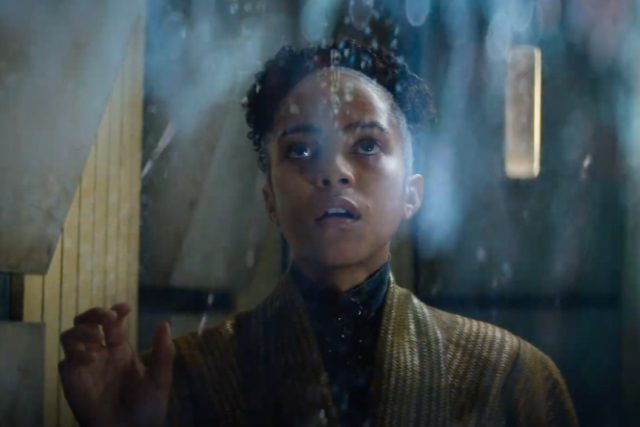
I had to figure out ways of having characters embody his themes. So the question that I posed to my writers and my actors, my directors, any time we were going over a scene was, I know we've got spaceships and we've got robots and we've got nanotechnology and gene editing. But if we strip all of this away, does this story still work on a purely emotional, contemporary level?
Take Dawn, the youngest Cleon. That's a story about a teenager who doesn't feel secure in his own skin. I think a lot of people can relate to that. It's also a story about legacy and sacrifice and what we are willing to give up for future generations, for our children. I don't think I could have adapted this prior to being a father. I don't think I thought that much about what the world was going to be like for my hypothetical children. But I think about that a lot now.
Kevin Hand: From a science standpoint, it's not just the magnitude of concepts like psychohistory. One could imagine that conscious beings could eventually be treated like particles in a thermodynamic system, so there might be some mass predictability. That is easy to sustain from a plot standpoint because that's what Asimov did. But the rest of the Asimov stories are pretty choppy. The original books were not really books, they were stories—little vignettes set in different periods of the galactic fall and the rise of the Foundation. As great as the original Asimov books are, from a character standpoint, they're relatively weak. David and his team had to figure out how to maintain character consistency, as well as consistency of scenes associated with those characters. And that means maintaining consistency in the planetary environments and establishing shots of the solar system, to give a sense of where you are as you go through the galaxy.

So my role has largely been helping define and refine the solar systems and planets on which the characters act and on which the plots unfold. David loves thinking about different kinds of stars. Could we have a planet around a pulsar in this scenario, because a pulsar is just visually cool? But then we have to deal with the radiation environment that any organism would experience on that world. Do you want photosynthesis to happen on a planet? If so, you're subscribing yourself to some variation of a G2 type star that allows yellow light to be the driving force for green plants to flourish. Certainly there might be plants that utilize other pigments on other worlds, but then you hit a practical constraint: if we're filming in a jungle on Earth, you're stuck with green.
We're looking at a storyline that could go on for eight seasons. So you don't want to make a decision that you're going to regret later on. You don't want to commit yourself to a planet that has certain characteristics, and then later on regret the choice of those characteristics. There's a lot of thinking about the immediate needs of science and planetary context for an episode. But also, is this a planet that's going to be in the show for the long haul? Or is this just a one-off?
Ars Technica: The destruction of Trantor's space elevator, the Skybridge, is a focal point of the pilot episode. What were the scientific considerations involved in staging that?
Kevin Hand: We had to think about the rotation of Trantor. What happens once you destabilize the top? Instead of just crashing down straight at the base, you're wrapping around the planet. That much we know would certainly happen. Then you have to factor in the atmosphere and momentum. Would it spiral as opposed to just laying down flat? We played around with a few different scenarios. In the end, there is that scene of the Skybridge laying down like a long cord across the planet. That helped cut that chasm and set the stage for certain characters later going into that chasm and seeing the sub-levels of Trantor.
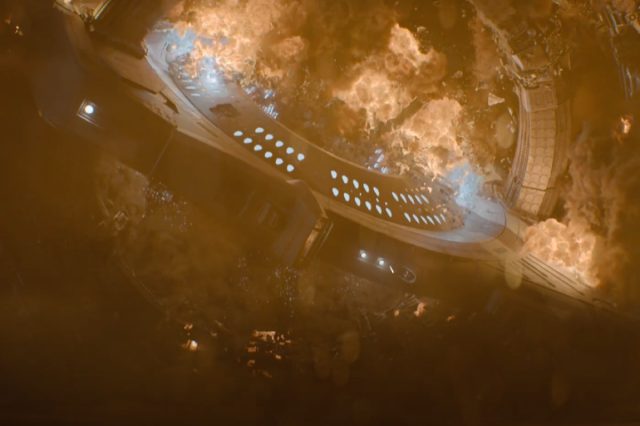
Ars Technica: David, you've said that you consider time to be a character in its own right in this series, because the books span thousands of years. Can you expound upon that?
David Goyer: In my first meeting with Apple, I said, I don't think it's possible to adapt this without taking time jumps. Sometimes we are going to jump forward a generation. Sometimes we're going to jump forward 100 years. Sometimes we're going to jump back 400 years. Sometimes we're going to tell two stories that are not in parallel timelines. I need to know that you're okay with that. If you're not, I don't think we can do this show.
The tropes of science fiction allow us to explore time in ways that we couldn't do in a contemporary drama. We can deal with a character going into cryo sleep and waking up 40 or 50 years later, we can deal with crazy concepts like time dilation, where time is relative. All of that is nerdy and technological, but it's only interesting if it's also emotional. Episode five is a major one for Gaal's story. It very much plays with time in all sorts of different ways. The first season is largely narrated by Gaal. I'm interested in unreliable narrators. This isn't just purely an omniscient narration. Gaal is telling the story from some distant point in the future and reflecting back on what we've seen. What is she editing out? What is she adding? Is it a subjective depiction of the events that are unfolding or is it objective?
There's a lot of power in history. What we choose to forget and what we choose to remember, what we choose to record in history is important because it changes our orientation to the past and to the future. Hari Seldon is using psychohistory to predict the broad movements of civilization. He can't predict your individual lifeline, what you had for dinner, but he can predict the broad movements of humanity. Is he predicting a probable future or a definite future? And when you're dealing with predicting the future, what does that mean in terms of our own human agency?
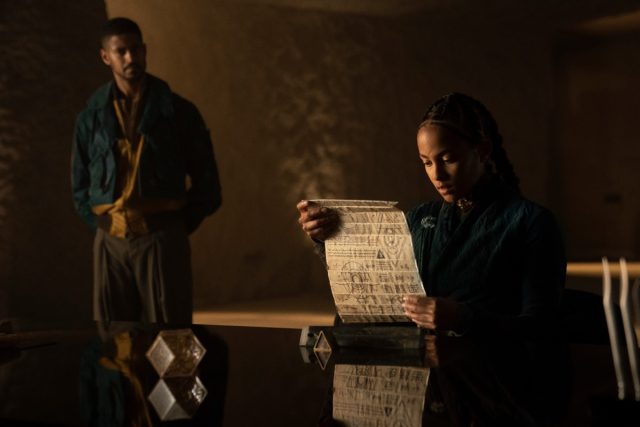
Ars Technica: Math is also a character of sorts, and I especially loved how you portrayed the mathematics. It's visually elegant and arresting, but also, in a way, emotional and human.
David Goyer: It's funny because math was the one subject in school that I was terrible at. I had a mathematical block, even with a tutor. I got D's. But I was always fascinated with math. I always wished in another life, I could have been a mathematician. I approached math in the show almost as if it were like communing with angels. I like this idea that Gaal and Harry are the only two people that can read the math. It's impenetrable to everyone else. When we talk about the prime radiant and the depiction of math, I wanted the visual depiction of it to be beautiful and almost mystical. I didn't want to have Roman numerals. We did a lot of concept art and visual effects tests for how the math would be portrayed.
Ars Technica: It's always a challenge to determine just how accurate the science needs to be in a fictional series. Kevin, what was your basic philosophical approach as science adviser?
Kevin Hand: Our attitude was, let's do our best to have a decent degree of fidelity to the science, but not lose sight of what's going to be dramatically gratifying and serve the story well. As you well know, the science on-screen does best when the stories and characters drive what you're watching and the science is incorporated in a way that doesn't jar you out of the story. If it's bad science, then it's just a laughable film, but if you're overly subscribed to the science, then that breaks the viewer's connection to the story also. The classic example is the attempt to retroactively explain the Force in Star Wars. You just didn't need to go there scientifically.
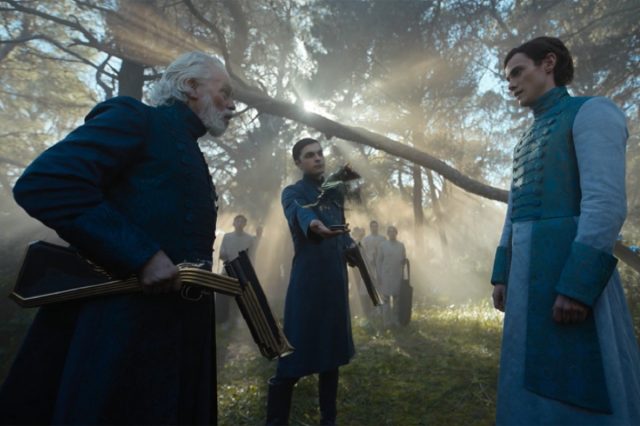
For example, in the scene where a professor on Synnax is drowned, originally he was just tied to books. But books are not going to sink anybody, so you need to tie some rocks to those books. Also, you want the planets to appear majestic, with moons and rings. But if you actually do the Kepler's law analysis of how fast a world should be going at what distance, you end up with systems that are somewhat similar to the Earth and our moon. As big and beautiful as our moon is, it's really not that big in our night sky. So if you want a dramatic establishing scene of rings and moons, you need a bit of Keplerian leniency as to where exactly you place the planet and how fast it goes. Just go with a nice visual and don't worry about the rotation of moving around the planet.
The scene where Dawn jumps off the ledge is a good example of knowing when science can inform you about what not to show. In the original script, you see him slam down into the ground, but if he really had a protective force field, he would bounce. If you want to show the full fall, then you're going to have to show this bounce. Or just show kind of the aftermath, which is exactly what they did. You see the initiation of the jump and then you see him just kind of suspended. That's a beautiful way to incorporate science in a way that doesn't actually show on the screen, but helps inform a scene.

Ars Technica: David, you've talked about how you saw so much more in them when you re-read the books in your forties, compared to reading them as a young man. That element is incorporated into the Cleons. Brothers Dawn, Day, and Dusk are genetically the same person, yet their outlook changes as they age. To me, this says something about the timelessness of Asimov's series, and why they still resonate today.
David Goyer: The show is about the politicization of science. Three years ago, when I was adapting it, the pandemic was not on any of our minds. I would argue that Foundation is even more relevant now than when Asimov was writing about it 70 years ago. And it's certainly more relevant now, three years later than when I started adapting it—almost eerily so.
My father first gave me the books when I was 13. He was a fan of science fiction, and he said it was the greatest science fiction work ever created. We didn't have a great relationship, so I didn't even read it until I was in my mid-twenties. I was still youthful and impetuous. I'd been told this was an important work, but I found it dry, and I didn't get it. I picked it up again in my forties after I became a dad, when I wasn't maybe so impetuous and was reflecting back on my life—reflecting back on cycles that I had followed.
I think Asimov was on to something, not just with Foundation, but in its approach to history. It's that humanity and history are cyclical. It's human nature when you're young to want to discount everything that's come before, to feel like you're unique and that you're just discovering the stars for the first time. And then it's human nature as you get older to realize, in some ways you are unique, in some ways you're not. There's a beauty and wisdom in the past, and the people who have come before you, and you learn to embrace that. That's the journey that I think we take as human beings, and that's the journey that's dramatized by Dawn, Day, and Dusk in the show. That was certainly my journey when I was introduced to Foundation.
All episodes of Foundation S1 are now streaming on Apple TV+.
reader comments
374